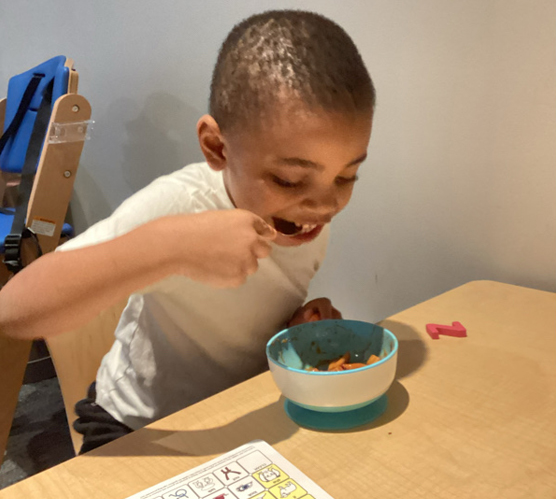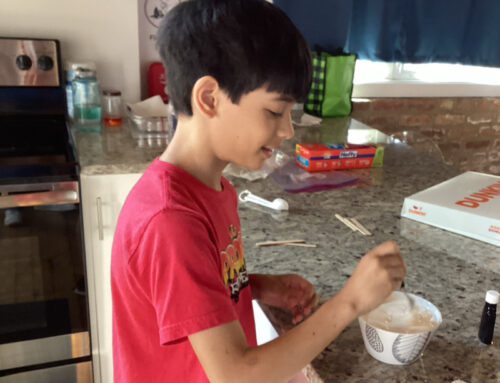Mealtimes are fun times for family connection and nourishment. When you’re raising a child on the autism spectrum, these moments can sometimes be challenging. Many children with autism struggle with picky eating habits, which can cause stress and frustration for the whole family. As a result, the dinner table can sometimes feel like a battlefield, so it is important to manage mealtime moments with a sensitive, personalized approach.
Are children with autism really picky eaters?
Autism is described as a spectrum because every individual’s abilities, strengths, and needs are distinct. Neurodiversity is the concept that brain function differences are a normal variation in human beings. Neurodiverse children process sensory information differently. They experience sounds, tastes and textures, especially during mealtime, in a unique way.
Picky eating, or feeding selectivity, is one of the most common challenges families face. It is more than just a behavioral quirk; it’s a complex issue rooted in sensory sensitivities, a need for routine, and sometimes underlying medical factors.
This guide was written to provide you with knowledge and practical, evidence-based, strategies that you can employ at home and at school. By using the right strategies, you can transform your mealtimes into quality family time.
Why Are Children with Autism Often Picky Eaters?
Understanding the “why” behind your child’s eating habits is the first step toward finding effective solutions. It’s rarely about defiance. Instead, it’s often a direct result of the way your child experiences the world.
Sensory Sensitivities:
For children with autism, sensory information can be intense and overwhelming. What might be a pleasant aroma to you could be overpowering to them.
- Taste and Smell: A food’s flavor might be too strong, sour, or bitter.
- Texture: This is a major factor. The feel of a food in their mouth—slimy, mushy, crunchy, or lumpy—can be highly aversive. Many children prefer dry, beige foods (like crackers, chicken nuggets, and pasta) because their texture is predictable.
- Appearance: The color, shape, or even the way food is arranged on the plate can be off-putting. A green bean touching a potato can be enough to render the entire plate inedible for some children.
- Sound: The noise of chewing crunchy foods like apples or celery can be distressing.
Need for Sameness and Routine:
Predictability is comforting. Children with autism often thrive on routine, and this extends to their food choices. They may insist on eating the same foods, prepared in the exact same way, every single day. A specific brand of yogurt, a certain shape of pasta, or a sandwich cut into perfect squares provides a sense of safety and control in a world that can feel chaotic. Any deviation from this routine can cause significant anxiety.
Oral Motor Difficulties:
Some children may have challenges with the physical act of eating. Weakness in the jaw, tongue, and lip muscles can make chewing and swallowing difficult or tiring. They might prefer softer foods that require less effort to eat. An occupational or speech therapist can assess and address these oral motor challenges.
Co-Occurring Medical Issues:
Gastrointestinal (GI) problems are more common in children with autism. Issues like acid reflux, constipation, food allergies, or stomach pain can create negative associations with eating. If a child feels discomfort after eating certain foods, they will naturally learn to avoid them. It’s always important to rule out any underlying medical conditions with your pediatrician or a gastroenterologist.
Debunking Common Myths
Navigating advice from well-meaning friends, family, or even online sources can be confusing. Let’s clear up a few common misconceptions.
- Myth: “They’ll eat when they’re hungry enough.”
- Reality: This approach can be counterproductive and even harmful. For a child with severe sensory aversions or anxiety, the discomfort of eating a non-preferred food can be greater than the discomfort of hunger. Withholding food can increase stress, reinforce negative associations with mealtimes, and potentially lead to nutritional deficiencies.
- Myth: “It’s just a phase they will outgrow.”
- Reality: While many toddlers go through a picky eating phase, severe feeding selectivity in children with autism often does not resolve on its own. It is typically tied to core characteristics of autism, like sensory sensitivity and rigidity. Without support and a structured approach, these patterns can become more entrenched over time.
- Myth: “You’re a bad parent for ‘giving in’ to their demands.”
- Reality: This is perhaps the most hurtful myth. You are not a bad parent; you are a responsive parent trying to ensure your child eats. Forcing a child to eat aversive foods can create trauma and escalate power struggles. A compassionate, gradual approach is far more effective for long-term success. Your goal is progress, not perfection.

Evidence-Based Approaches to Expand Your Child’s Diet
Transforming your child’s eating habits is a marathon, not a sprint. The key is to be patient, consistent, and celebrate every small step forward. Here are some trusted, evidence-based strategies that we use and recommend.
Food Chaining
Food chaining is a highly effective, individualized approach that builds on the foods your child already accepts. It involves introducing new foods that have similar sensory properties (taste, texture, temperature, or appearance) to their preferred foods.
How it works: Start with a food your child loves. Let’s say it’s a specific brand of chicken nugget. The “chain” might look like this:
- Step 1: Introduce a different brand of chicken nugget.
- Step 2: Introduce a different shape of chicken nugget from the same brand.
- Step 3: Introduce homemade chicken nuggets with a similar breading.
- Step 4: Introduce breaded fish sticks (similar texture and color).
- Step 5: Introduce baked fish with a sprinkle of breadcrumbs.
Each step is a tiny, manageable change. The goal is to slowly stretch your child’s comfort zone without causing distress, building a bridge from the familiar to the new.
Systematic Desensitization and Food Exploration
This approach is all about reducing the fear and anxiety associated with new foods through no-pressure exposure. The focus is on interaction, not consumption.
Steps of Interaction: Create a hierarchy of steps for interacting with a new food. The goal is to move up the ladder over time, with no pressure to eat.
-
- Tolerating the food on the table.
- Tolerating the food on their plate (without having to touch it).
- Touching the food with a fork.
- Touching the food with their fingers.
- Bringing the food to their lips.
- Licking the food.
- Putting the food in their mouth (and can spit it out).
- Chewing the food once (and can spit it out).
- Chewing and swallowing a tiny bite.
This process should be playful and low-stress. Use sensory bins with dry pasta, “paint” with yogurt, or build with vegetable sticks. Celebrate any level of interaction!
The Power of Routine and Positive Reinforcement
Leverage your child’s love for predictability to your advantage.
- Consistent Meal Times: Serve meals and snacks at roughly the same time each day. This helps regulate their appetite and makes mealtimes an expected part of the routine.
- One Family Meal: As much as possible, prepare one meal for the entire family. Always include at least one “safe” food on your child’s plate that you know they will eat. This removes the pressure to eat the new foods but ensures they have something to fill their tummy.
- Praise the Effort, Not the Outcome: Offer specific, positive reinforcement for any interaction with a non-preferred food. Instead of “Great job eating your broccoli!”, try “I love how you touched the broccoli with your fork!” or “Thank you for letting the peas sit on your plate.” This rewards their bravery and effort, making them more likely to try again.
Eating at School and Managing Snacks
The school environment introduces a new set of variables: different routines, less direct supervision, and social pressures. Partnering with your child’s school is essential for creating a consistent and supportive experience.
Lunch at School
For many children with autism, the cafeteria can be a sensory nightmare—it’s loud, crowded, and filled with unpredictable smells. A packed lunch often provides the comfort of predictability.
- Communicate with the School Team: Your child’s success starts with collaboration. Share your child’s list of preferred and non-preferred foods with their teacher, paraprofessional, and school social worker. Discuss the strategies that work at home. This information can be included in their Individualized Education Program (IEP).
- Pack “Safe” and “Exploring” Foods: Pack a lunch you know your child will eat to ensure they have enough energy for the school day. You can also include a very small portion of an “exploring” food in a separate container. Let the school staff know the goal is simply exposure, not consumption.
- Consider the Environment: If the cafeteria is too overwhelming, ask about alternative lunch locations. Can your child eat in the classroom with a small group, in the library, or in a quiet resource room? Creating a calm environment can significantly reduce mealtime anxiety.
- Use a Thermos: If your child prefers warm foods like pasta or chicken nuggets, a good-quality thermos can keep their food at the right temperature, maintaining its familiar texture and taste.
Managing Snacks
Snacks are a great opportunity for low-pressure food exposure and for ensuring your child maintains their energy and blood sugar levels throughout the day.
- Structure Snack Time: Just like meals, having scheduled snack times can prevent constant grazing, which can interfere with appetite at main meals. A common schedule is one mid-morning and one mid-afternoon snack.
- Pair Preferred with New: Use snacks as a chance to practice food chaining on a smaller scale. Pair a favorite cracker with a tiny smear of a new dip, or a few familiar pretzel sticks with one new vegetable stick.
- Keep it Simple and Empowering: Let your child help pack their snacks. Giving them a choice between two acceptable options (e.g., “Do you want apple slices or a cheese stick for your snack?”) can provide a sense of control and increase the likelihood they will eat it.

Frequently Asked Questions (FAQ)
Should I hide vegetables in my child’s food?
While it can be a tempting short-term fix to boost nutrition, it’s generally not recommended as a primary strategy. It can erode trust if your child discovers the hidden ingredient, potentially causing them to reject a previously “safe” food. It also doesn’t teach them to accept new foods in their original form. A better approach is to focus on open, no-pressure exposure.
My child only eats crunchy/soft foods. How can I introduce other textures?
This is a classic example of where food chaining shines. If your child loves crunchy pretzels, try other crunchy foods like veggie straws, freeze-dried apples, or different types of crackers. If they only eat soft yogurt, try introducing a smoothie, then a thicker smoothie, then applesauce, and eventually maybe a pureed fruit pudding. The change should be gradual and almost unnoticeable.
What about nutritional supplements or drinks?
Nutritional drinks can be a valuable safety net, especially during periods of extreme food selectivity. They can help fill nutritional gaps and reduce your anxiety, which in turn can lower the pressure at mealtimes. However, they should be used in consultation with your child’s pediatrician or a registered dietitian. The goal is for supplements to support, not replace, efforts to expand their diet with whole foods.
How long will this take? I feel like we’re not making any progress.
Progress is often slow and non-linear. There will be good days and bad days. It’s crucial to redefine what “progress” looks like. One week, it might be licking a carrot. The next month, it might be swallowing a tiny piece. Documenting these small wins can help you see the forward momentum over time. Remember to be patient with your child and with yourself. You are building skills for a lifetime.
When should I seek professional help?
If you feel overwhelmed, your child is losing weight, or you have significant concerns about their nutritional status, it’s time to call in support. A multidisciplinary team can be incredibly helpful. This may include:
- Your Pediatrician: To rule out any underlying medical issues.
- An Occupational or Speech Therapist: To address oral motor skills and sensory processing challenges.
- A Registered Dietitian: To create a plan to address nutritional gaps.
- A Board Certified Behavior Analyst (BCBA) or Psychologist: To help with the behavioral and anxiety components of feeding.
At Eyas Landing, our team of multi-disciplinary therapists work together to provide this kind of comprehensive support. We believe in partnering with you to create individualized plans that honor your child’s unique needs and empower them to build confidence, one milestone at a time.
Your child’s journey with food is part of their larger developmental path, and with the right support, progress is always possible.

Eyas Landing is a therapy clinic with a mission to provide evidence-based and family-centered therapy services for children, adolescents, and their families. The primary goal is to deliver relationship-based interventions within the most natural environments and to empower families to reach their full potential. To achieve this goal, our highly educated, compassionate staff dedicates time and expertise to create experiences that maximize therapeutic outcomes. The strength, determination, and perseverance of our clients are evident as they succeed in therapy, and ultimately in their daily lives.
Eyas Landing offers a wide range of comprehensive services including Speech Therapy, Occupational Therapy, Physical Therapy, ABA Therapy, Social Work, Family Therapy, and Neuropsych testing. Services are provided throughout the Chicagoland area via Telehealth, In-Home, and in our state of the art clinic.
Want to learn more or you have a specific question? Feel free to connect with us here!



